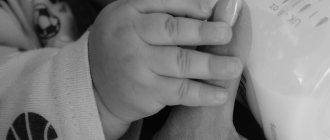Restless behavior of a baby during feeding is not at all uncommon. With this problem, parents often turn to pediatricians and lactation consultants. Before you panic, you need to understand why the child eats breast milk restlessly and why such attacks occur.
Baby restlessly eats breast milk
Why is a baby anxious when breastfeeding?
The reason why a child behaves restlessly during breastfeeding may be physiological in nature, may be due to illness, or may have a psychological basis. This manifests itself in restless behavior at the breast: the child arches, taps his foot, and turns away from the breast. The probable reasons for a baby's restless behavior during breastfeeding can be varied.
Lack of milk
This is the very first reason that comes to mind for many mothers if the baby is nervous during feeding. Indeed, if the baby had eaten enough, he would have been calm. Since he is worried, it means that he is not satisfied with the amount of milk, therefore, he does not finish eating. This is what nursing mothers and their frequent assistants, grandmothers, think. Their experiences are understandable to some extent - when breastfeeding, it is difficult to measure how much milk the baby drank. Most often, fears and worries about a “hungry” baby are unfounded.
There are very specific indicators of child development. These include the following parameters:
- monthly weight gain - within 2 weeks after birth, the baby should regain its birth weight, and then gain approximately 600-800 g each month;
- regular urination and bowel movements - the “wet diaper” test should be tested at least 10 times a day, soiled diaper - 1-2 times a day;
- the child’s general satisfactory condition – activity during the day, absence of pale skin and signs of dehydration.
Breast swelling
It can occur in the first weeks after childbirth, when milk “rushes” and a feeling of fullness is created. Indeed, this can lead to anxiety for the baby, since he literally cannot latch on to the nipple. In such a situation, pumping will help. It is necessary to express some milk by hand or with a breast pump before feeding. The breast will become softer and the baby will be able to grasp the nipple. You only need to express a small amount so that milk production does not increase. Otherwise, next time there will be much more of it, and the problem will repeat.
The baby cannot latch onto the nipple due to breast swelling
Flat nipples
They can interfere with the process of “producing” milk, and the baby at the breast becomes nervous. This cosmetic defect can also be successfully dealt with: before feeding, express a little milk with a breast pump. It “pulls out” the depressed nipples and starts the flow of milk. The child will immediately receive the long-awaited food and successfully continue to eat instead of crying. You can also use special silicone nipple covers. There are two types: special pads for feeding and pads for wearing on the chest in between feedings. They precisely “pull out” the nipples.
Incorrect posture
Inconvenience when feeding causes concern not only for the child. The nursing mother herself experiences it. In this case, she may subconsciously shorten the feeding time in order to complete it as quickly as possible. The child should feel confident and calm, for this he must be pressed tightly, held by the shoulders and buttocks so that he does not slip when sucking. The baby's nose and chin should rest against the chest, then he will suck confidently and calmly. You can feed while lying down or holding the baby in your arms; this is done at will and convenience. The main thing is that the actors in the important process feel comfortable.
Uncomfortable posture can cause crying
Gastro-food reflux
This is a condition also called heartburn. A small amount of milk, along with gastric juice, flows back into the esophagus and causes discomfort. To stop the attack after feeding, the child must be held in an upright position. This also to some extent solves another problem - the baby will stop burping after eating.
Increased gas formation
Flatulence often bothers a newborn baby, and when breastfeeding the child freaks out. Due to its ease of absorption, breast milk quickly passes through the gastrointestinal tract. Characteristic sounds can be heard when the baby has not even finished sucking the breast. This is especially pronounced in the afternoon. Some foods that a nursing mother eats can increase flatulence. This applies to a greater extent to the group of legumes and various types of cabbage. In such a situation, it is important to monitor your diet and eat less of these dishes or temporarily eliminate them altogether.
Physiological lactase deficiency
This condition is caused by a lack of an enzyme found in hindmilk. It is rich in fats, which neutralize lactose and reduce flatulence. If a baby restlessly sucks at the breast or spends little time on it, he does not get to the “hind” milk, limiting himself only to the “front” milk. It is the “hind” milk that saturates the baby, has a calming effect and reduces anxiety. After a “hearty” meal, he is more likely to fall asleep.
A child chokes on milk
Under the influence of strong pressure, the baby chokes on milk at the breast. It is necessary to squeeze the breast strongly and stop the flow, and then give it to the baby again. Or express a little milk before feeding to reduce pressure. As the child grows up, he will learn to cope with any quantity and pressure of milk; he just needs help in the beginning to adapt to this physiological feature.
Smell
A pungent and unusual smell can displease a child, so much so that he refuses to eat. During lactation, it is recommended not to use creams, perfumes and aromatic soaps with strong fragrances, so as not to displease the baby.
Thrush
An infection in a baby's chest or mouth is called thrush, caused by Candida fungi. White spots appear in the baby's mouth, and there may be redness on the nipples. When feeding, unpleasant sensations appear - burning and itching. If you suspect an infection, you must seek qualified medical help and, if the diagnosis is confirmed, undergo a course of medication with your baby.
Important information! Many babies who are familiar with a pacifier or bottle latch on incorrectly.
If the latch is incorrect, they are unable to obtain milk, as a result of which the desire to suckle disappears.
Breast refusal. Why doesn't the baby latch on?
Breast refusal. Why doesn't the baby latch on? Have you noticed that your baby is reluctant to take the breast? Takes it and immediately throws it away? Does he cry at the breast or not at all? Do you want to understand why a baby refuses breastfeeding and how to deal with it? In this article, we'll explain what breast refusal looks like, what causes it, and what you can do to overcome it. What does breast refusal most often look like:
- the baby begins to arch and turn away from the breast;
- does not take the breast, but calmly takes the pacifier and falls asleep with it;
- sucks a little and immediately begins to cry, takes the breast again and again and screams;
- takes one breast, but does not take the other;
- begins to cry at the sight of a breast;
- breastfeeds only when half asleep (or especially well when half asleep)
It looks like a refusal, but it is not a refusal!
The reasons may be different:
- The child cannot attach to the breast from birth, or takes the breast and loses it almost immediately after the start of sucking. Most likely this is due to the anatomical features of the baby or breast, the method of attachment, etc. Such a mother-baby pair needs to learn how to attach to the breast, after which the child will take and suck the breast.
- The baby is distracted during feedings and often comes off the breast. Grown-up children, usually starting from 2-3 months, become very curious and are easily distracted by the sounds, objects, people, etc. around them. Also, if a slightly older child is already full, he will not always want to suckle at the breast almost immediately after feeding, even if it is convenient or necessary for the mother.
- The child is sick or feels unwell. Various diseases (eg, otitis media, stomatitis, runny nose, sore throat, cephalohematoma, teething pain) can cause discomfort when sucking. Therefore, first of all, it is important that the child receives adequate treatment, in which he can quickly return to full breastfeeding. In the meantime, while it is painful for the baby to suck, you can feed or supplement with expressed milk from non-sucking objects - a spoon, a cup, a syringe without a needle.
- "Nipple confusion." If your baby frequently sucks on a bottle, he may become so accustomed to its characteristics (the material of the nipple, the ability to chew it with his gums, the speed of flow during feeding, or the lack of flow when falling asleep with a pacifier in his mouth) that the breast becomes an unusual and less preferred way of feeding and soothing. .
- Stress. For better development and psychological well-being, a child needs stability, and stability for him is the satisfaction of his innate expectations. Nowadays, just like thousands of years ago, babies still expect their mother to carry them in her arms, feed them often, not leave them alone and protect them from the outside world. Therefore, some especially sensitive babies may react sharply to sleeping in a separate room or even a crib, to a strict feeding regime, as well as to a change of environment while traveling, with crowded and noisy guests, as well as various manipulations, such as dynamic gymnastics, active diving or dousing with cold water for hardening.
- Too active introduction of complementary foods or formula. Refusal to breastfeed in this situation is due to the fact that the child is full or even overeating, and his need to suckle from the breast becomes less.
Is it possible to cope with breast refusal? Although breast refusal remains one of the leading reasons for stopping breastfeeding, we know for sure that we can overcome it. As you can see, the reasons for breast refusal can be very different, and therefore the methods of overcoming it can vary greatly in each specific case. Most often, the symptoms of breast refusal increase gradually and the faster the mother pays attention to the signs of emerging difficulties, the faster and easier she will cope with them. Where to begin?
- Analyze recent events. Try to understand at what point the baby began to worry at the breast, which could influence this behavior. Have there been any changes in your home routine or baby care?
- Make sure your child is healthy. Examine the oral cavity yourself for visible changes, and also consult with your pediatrician about other possible causes.
- Feed and calm. Regardless of the reasons for refusal, the child must receive the required amount of nutrition (expressed milk, donor milk or formula). Sleepy and calm babies suckle more readily, so before offering the breast to your baby, first try to relax him, for example with white noise (hair dryer, tap water), rocking, skin-to-skin contact, and then put him to the breast and allow him to suck as much as he wants. Also watch for signs of awakening: if the baby is not yet fully awake, then most likely he will calmly attach to the breast.
- If the child turns away at the sight of the breast, cries, or clearly does not want to suck, then do not insist. It will probably take some time before he is willing to latch on while awake.
- Look for positions in which your baby will latch onto the breast. Maybe the baby will want to take the breast in a biological latch, resting and relaxing on his mother’s belly, or maybe swinging with his mother on a fitball. Try a variety of options - from walking around the room with gentle rocking to taking a warm bath together.
- Eliminate pacifiers and bottles if possible. If you suspect that your baby has become worse at latching on the breast due to “nipple confusion,” then you should reduce the use of bottles and pacifiers to a minimum, and if possible, eliminate them completely. The baby will be more willing to breastfeed without having “sucking” alternatives. If additional feeding is necessary, give preference to non-sucking objects (cup, spoon, etc.). If eliminating bottle feeding is not an option, try paced bottle feeding, which allows you to regulate the flow (by tilting the bottle) and thus allow your baby to “induce a let-down” and only receive nutrition through active sucking.
- Reduce the amount of stress. If you think that the most likely reason for breast refusal is stress, then, depending on its type, take appropriate measures. A universal and effective way to help mother and child in this situation is to significantly increase the time of tactile contact between the baby and mother. Try to be as close to the baby as possible - hug him, kiss him, carry him in your arms or in a sling, sleep together, if possible. Some mothers like to create a cozy place for themselves where they can lie and cuddle with their baby, because close skin-to-skin contact allows you to relax and tune in to breastfeeding.
- Maintain a calm, supportive environment in your home. Screaming and swearing stress both the baby and the nursing mother.
- Try to temporarily give up some of your usual activities, such as diving, active hardening, dynamic gymnastics. It may be worth canceling or rescheduling some events - going to a party or another unknown environment can be stressful for the baby. Over time, the baby will be ready to expand his space and circle of acquaintances, you just need to give him time.
- Make sure your baby is not getting too much non-breastfeeding for his age. If necessary, reduce portions of complementary feeding or supplementary feeding, or introduce them more gradually.
If you understand that any of the above resembles your baby’s behavior at the breast, then it is important to find out the reasons as quickly as possible and get ready to go through this stage. Your confidence and attitude will play a leading role here, and the coping methods mentioned above will help you finally solve the problem. We wish you a successful and mutually enjoyable breastfeeding experience!
The child behaves nervously when feeding
There may also be a situation where the child lost psychological contact with his mother and did not get the food he wanted when he was hungry (it’s just that it’s not time for mom’s lunch yet, because she lives according to the correct routine). It happens that a baby is taught to swim and dive in a bathtub or even a pool, but he doesn’t like it at all, or he was handed over to strangers, and the baby felt betrayed and began to worry. There can be a great many reasons. The baby can only express his dissatisfaction by screaming and crying.
Restoring a child's calm
To restore mental and physical balance, you can use various methods:
- creating a cozy, calm atmosphere in the room: dim light from one lamp, without the TV, laptop or tablet turned on;
A cozy atmosphere as a source of calm
- All attention is only to the child - you can give a light soothing massage that will bring him pleasure.
Lullabies and fairy tales
Reading a fairy tale or singing a lullaby is recommended. The text of songs and fairy tales is not so important; special attention must be paid to intonation: a soothing, monotonous melody or a story with a simple plot, without vivid images, detailed adventures and descriptions.
A lullaby will help your baby calm down
Tactile contact
For feeding, you can try an unusual position: the mother lies on her back, and the baby sits on her stomach. In such an unusual position, the child will be distracted from the whims. It is important to ensure close tactile contact with the baby - it is no coincidence that children are called infants; their place is next to the mother's breast, not only during the feeding period. It is necessary to pick up, cradle and caress the baby more often so that he “remembers” the smells of his beloved mother and calms down.
The baby needs to be held more often
Feeding on demand
During the restless period, switch to feeding on demand. This is the best way to maintain lactation and establish a close connection with the baby; offer the breast every time he expresses the need by crying or just sniffling.
In any case, no matter what is the cause of the child’s restless behavior, you should not stop breastfeeding and switch him to baby formula from a bottle. By any means necessary to maintain lactation. Many problems will be resolved over time, but restoring guard after a long break is very difficult.
Causes
There are many reasons why a baby may cry while breastfeeding. Below is a list of the most likely causes.
- Milk comes from the breast very quickly, in a strong stream, and the baby does not have time to swallow it. In this case, the child gags and cries. He swallows a lot of air, which causes abdominal pain. The child associates feeding with pain.
- The milk comes from the breast too slowly and incompletely, leaving the baby hungry and irritable.
- You are feeding your baby in the wrong position, so he cannot latch on properly. As a result, the baby feels uncomfortable or has a shallow latch and cannot get enough milk.
- The child is afraid of pain. This may occur when a baby (for example, after a caesarean section) has had mucus roughly removed from the mouth by mechanical or manual suction and has a persistent association with mouth pain. Fortunately, this situation is reversible; in case of hunger, the taste of milk and the gentle care of the mother convince the baby that suckling at the breast is very useful.
- The child refuses to suckle due to severe drowsiness. This situation usually occurs after a long and difficult birth, and also if pharmacological drugs were used and the child is affected by medications prescribed by his mother. This can also occur with jaundice in newborns.
- The child refuses to latch on to the breast due to the pain of feeding. This may happen if the child:
- teeth are cutting through;
- there are aphthae and mouth ulcers;
- have a throat infection;
- have ear infections;
- there are colics in the stomach.
- The baby may refuse to breastfeed if the infection develops. He may be restless, irritable, with a fever and loss of appetite.
- The child has a cold. A runny nose makes breathing difficult and the baby stops breastfeeding.
- The baby does not want to breastfeed because he is in a new environment (too many distracting stimuli) or has received too much stimulation during the day. This can happen if the day is significantly different from the normal routine the child is familiar with.
- Refusal to suckle may be due to a change in the taste of the milk, for example if you have eaten bigos or dishes with a lot of garlic. The taste of milk may also change due to hormonal changes (for example, before menstruation or during pregnancy).
- The child is not hungry. If the baby has received additional food or drinks that fill him up and he does not want to breastfeed.
- The baby does not want to breastfeed because he prefers a bottle with a nipple. If you use bottle feeding with the wrong nipple, your baby may become accustomed to the easier feeding method and will now protest if you try to breastfeed. (See chapter Baby prefers the bottle.)
- Sometimes the reason a baby refuses to latch on is a change in the smell that is associated with you. For example, if you change your perfume or soap.
- The mood of a nursing mother can be transmitted to the child. When she is nervous and worried, the baby also becomes restless, whiny, and may refuse to latch on to the breast.
- When your baby bites your nipple painfully and you cry out loudly, he may be afraid of your reaction and will refuse to feed, fearing a repetition of this situation.
- If the child is too hungry. Severe hunger irritates the child and he cries desperately. It is difficult to put a baby to the breast when he is hysterical and completely exhausted. The baby sucks milk so greedily that he swallows a lot of air. As a result, his stomach begins to hurt, he stops sucking milk and cries again...











